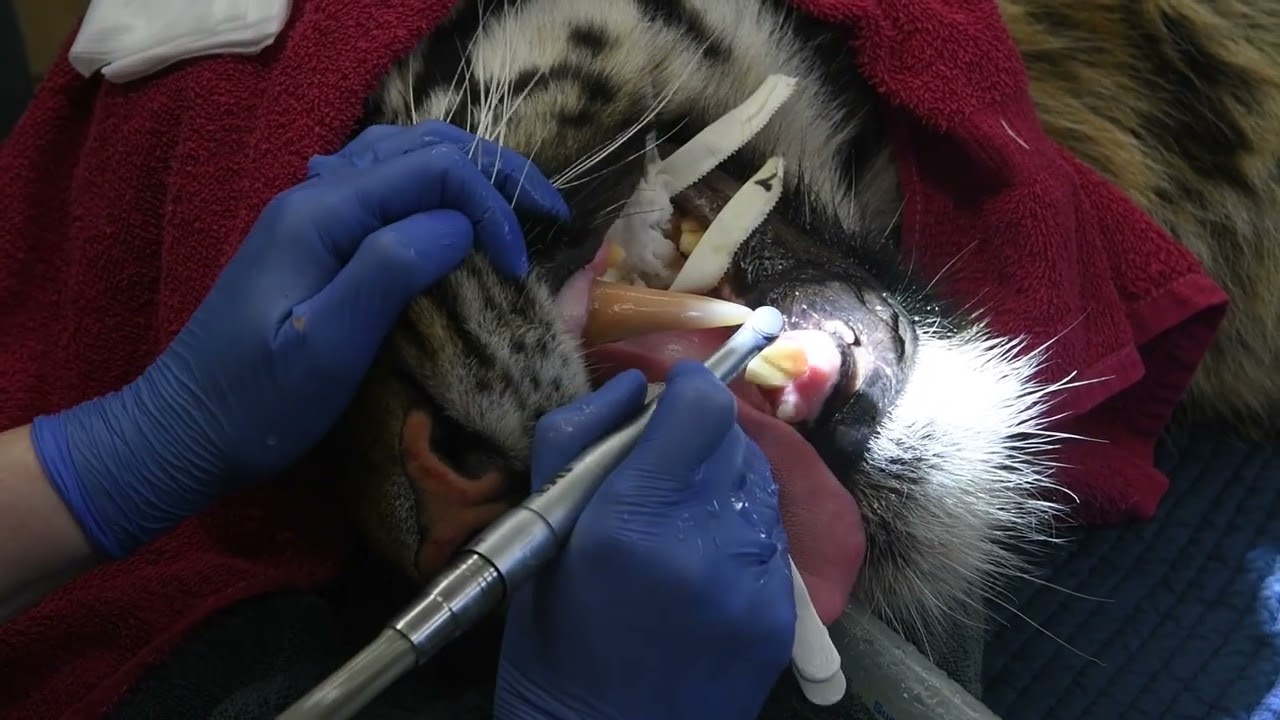– The critical importance of dental care in large felines like the Sumatran tiger Sanjiv
– The process and logistics involved in a large feline receiving a dental cleaning and root canal procedure
– The veterinary challenges and innovations in the treatment of endangered animals in captivity
– The significance of veterinary care in prolonging the life and health of endangered species like the Sumatran tiger
Have you ever considered what goes into maintaining the health of the captivating creatures we admire at our local zoos? Today, we’ll sink our teeth into an extraordinary aspect of animal care as we uncover the compelling details behind the dental care of one of the most enigmatic felines – the Sumatran tiger. Our focus will be on the majestic Sanjiv and his recent trip to the dentist, which might sound like a walk on the wild side. Still, it’s all in a day’s work for the veterinary specialists dedicated to ensuring the vitality of these magnificent animals.
Sanjiv’s story is not just an isolated event but a narrative woven into the larger fabric of conservation efforts and medical leaps in the animal kingdom. To understand the significance of a single tiger’s dental health, we must first appreciate the interlocking nature of ecosystems and the creatures within them.
Let’s venture into the jungle of details that make up the world of zoo-based animal dentistry, shall we?
When we picture the striking image of the Sumatran tiger, the first thing that often comes to mind is their captivating stripes, piercing eyes, and impressive fangs. However, beneath the aesthetics of these fierce fangs lies a world of complexity. Dental health is paramount to a predator’s survival, especially in captive environments where every aspect of an animal’s health is meticulously managed. Sanjiv, our 12-year-old tiger protagonist, recently undertook a journey typically reserved for humans – a dental cleaning and a root canal procedure.
Embarking on such medical procedures with a creature of Sanjiv’s caliber is no small feat. It requires a highly skilled team of veterinary professionals who understand the technicalities of their trade and profoundly respect the animal in their care. A Sumatran tiger’s dental appointment involves intricate logistics, including state-of-the-art medical equipment, a thorough understanding of tiger anatomy, and a hefty dose of courage.
Sanjiv’s fractured tooth was not merely an aesthetic concern or a threat to his carnivorous lifestyle; it posed a risk to his overall health. In the wild, a compromised tooth could lead to an inability to hunt effectively, and in the zoo, an infection could quickly turn systemic. Therefore, state-of-the-art veterinary dentistry comes into play, merging the ancient art of animal care with the latest medical technology.
The day of the procedure saw Sanjiv transported carefully to the veterinary suite of the zoo, an area off-limits to guests and shrouded in the same mystery as the hidden enclaves of Sumatra itself. In this modern den, the tiger would be rendered unconscious through carefully calculated anesthesia—requiring monitoring equipment akin to what you’d see in human hospitals—to ensure the big cat’s heart rate, oxygen levels, and blood pressure remained healthy throughout.
As Sanjiv lay in slumber, the veterinary team meticulously performed the dental cleaning. Tartar was removed, gums were inspected, and the fractured tooth—no doubt a scar from an energetic play session or a particularly resistant meal—was given a root canal. This procedure involved removing the infected pulp, disinfecting the cavity, and finally filling it to restore the tooth’s strength. All were completed with surgical precision and delicate care to ensure the majestic beast would wake with his biting prowess intact.
The challenges faced in providing such specialized care to large predators in zoos are vast, from the pharmacological considerations needed to safely anesthetize them to the behavioral training that often precedes such procedures to ensure minimal stress for the animal. With species like the Sumatran tiger, whose numbers are dwindling rapidly in the wild, the stakes for each animal are even higher.
The lessons learned from Sanjiv’s story are rooted in a broader context of conservation medicine. Facilities that house endangered species become crucial for integrating veterinary care, research, and public education. Each cleaning, each root canal, matters not only for the individual but for the species as a whole. Zoos have transitioned from menageries to critical hubs for education and preserving biodiversity.
Moreover, veterinary advancements and specialized care like this are seeding hope for the future. With each successful procedure, the pool of knowledge deepens. Veterinary professionals equipped with the ability to care for these animals contribute to their well-being and the broader conservation mission.
Sanjiv, post-procedure, remained under observation as the effects of the anesthesia waned. The tiger’s awakening is symbolic of a larger awakening—a growing recognition of the intrinsic value of each creature and the interconnectedness of their health with the health of entire ecosystems.
As visitors flock to marvel at Sanjiv, his story adds an invisible yet significant layer to their experience. His gleaming teeth are a testament to the untold hours of training, preparation, and courage that go into veterinary care at the zoo. His prowling presence is a gentle but powerful reminder of the tireless efforts to maintain the health of not just one tiger but a species on the brink.
Stories like Sanjiv’s offer a behind-the-scenes glimpse into the unseen world of zoo animal healthcare. In this world, every check-up, every cleaning, and every medical breakthrough play a definitive role in shaping the future of these animals.
*****
Source Description
Check out this exclusive behind-the-scenes look at our Sumatran tiger, Sanjiv, getting a dental cleaning! 🐯 Maintaining those pearly whites is essential for our furry friends, too. 😁✨ Last month, the 12-year-old tiger received a root canal to fix a fractured tooth. #DentalHealthMonth


